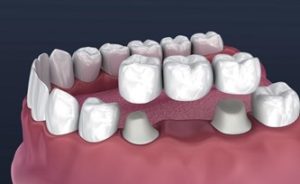Dental Bridges in Scripps Ranch

A dental bridge is a non-removable appliance that fills in the gap left by a missing tooth to recreate a complete, beautiful smile. Bridges restore full chewing and speaking ability, and help maintain a natural facial shape. They also prevent problems with the remaining teeth: for example, they prevent the teeth from drifting out of position or prematurely wearing down because they must compensate for the missing tooth.
An attractive, properly fitted bridge requires the skill and experience of a dentist like Dr. Jennifer Santoro. She understands the embarrassment and discomfort that a missing tooth can create, and she is committed to offering personalized dental solutions to improve dental appearance, function and comfort.
Replacing a Tooth with a Fixed Bridge
Fixed bridges are a good option if you are missing one or more teeth but still have some natural teeth that are strong and healthy. Bridges rely on the surrounding teeth for support and structure. A traditional bridge is constructed from two crowns that anchor an artificial tooth in the middle. The artificial tooth fits into the gap to create a literal bridge between the remaining teeth. The crowns are then attached to the teeth on either side of the gap, and the whole piece is bonded into place.
Fixed bridges are usually created from porcelain, which is a beautiful and functional material. The porcelain can be sculpted to recreate the appearance of natural tooth enamel. It’s also very durable and can last for many years.
Dental Bridge Placement Process

Dr. Santoro can replace missing or damaged teeth several different ways, so it is important to consult with her to find the approach that works best for you. She will want to complete a thorough examination to confirm that a bridge is the most suitable solution for your needs and goals. Also, there are several types of bridges and Dr. Santoro can explain the type that is ideal for your circumstances.
Placing a bridge usually requires two or more appointments. The first step of the bridge placement process is to prepare the anchoring teeth that will be crowned. Dr. Santoro may need to remove a small amount of tooth enamel to allow for the crowns, but she will preserve as much healthy tooth structure as possible. Next, impressions will be taken to send to the dental laboratory responsible for fabricating the bridge. A temporary bridge will be placed until your next appointment.
When your permanent bridge is ready, you will return to our office for another visit. During the appointment, Dr. Santoro will remove the provisional bridge and position your customized bridge. If you are happy with both the fit and the look of the permanent bridge, Dr. Santoro will cement the entire appliance into place.
With proper brushing and flossing, and routine dental visits, dental bridges can last many years.
Frequently Asked Questions about Dental Bridges
Who should get a dental bridge?
You may benefit from a dental bridge if you have one or more consecutive missing teeth. Perhaps you had a tooth knocked out from an injury or an accident, or you lost a tooth to severe decay or gum disease. A dental bridge will restore the appearance of a natural, healthy tooth, giving you the confidence that comes from a complete smile with no gaps.
Is a dental bridge removable?
Dental bridges are “fixed” into place, meaning they cannot be removed (unless by a dentist). Dr. Santoro and our hygienists will show you the proper way to brush and floss your fixed bridge, and we will recommend hygiene products to keep your restoration clean. We will also explain how often to see us for check-ups and professional cleanings.
Does placing a bridge affect the adjacent teeth?
In a traditional bridge, the teeth near the gap are slightly modified to support the restoration. This involves removing a small amount of tooth structure and crowning those teeth. In general, the less healthy tooth structure removed, the better. Dr. Santoro is very conservative when removing tooth enamel from the supporting teeth.
What is an implant-supported bridge?
An implant-supported bridge is similar to a traditional bridge, except that it is held in place with implant posts instead of natural teeth.
Implant-supported bridges are very stable and support normal eating and speaking. They also protect the underlying jawbone against atrophy. Because the implant posts replace the natural tooth roots, chewing on them keeps the jawbone engaged and strong.
Certain patients are not candidates for implant-supported bridges. If you are interested in securing your bridge to implant posts, ask Dr. Santoro about your options.
What are the other types of bridges?
A cantilever bridge is comprised of a prosthetic tooth attached to one supporting crown. The crown is placed over a tooth adjacent to the gap, and the prosthetic tooth fills the gap. Cantilever bridges are normally used for people who have natural teeth on only one side of the gap left by the missing tooth (e.g., the teeth in the back of the mouth).
A Maryland-bonded bridge is comprised of a prosthetic tooth supported by a framework of “wings” on either side. The wings bond to the back sides of the teeth adjacent to the gap and hold the artificial tooth or teeth in place. Maryland-bonded bridges are sometimes used to replace missing front teeth.
There are pros and cons to these bridges, which Dr. Santoro can review during your initial consultation.
How can I prolong the life of my dental bridge?
Diligent at-home care and regular professional checks will keep your bridge clean, intact and functioning optimally for quite a few years.
Dr. Santoro and our hygienists also encourage you to avoid biting or chewing on any hard substances — such as ice or shells — that could break or fracture the restoration. Also, refrain from using your teeth to open bottles or chew on pen caps, as these behaviors can be harmful to your bridge. And, if you have a habit of clenching or grinding your teeth, you may need to invest in a custom mouth guard to protect your bridge.
Is the Fixed Dental Bridge Process Painful?
 While the dental bridge process will take at least two appointments at our San Diego dentistry office, it typically involves minimal discomfort. Dr. Santoro takes great pride in patient comfort and will numb the tissues in the area with local anesthesia and test it to be sure you are sufficiently numb.
While the dental bridge process will take at least two appointments at our San Diego dentistry office, it typically involves minimal discomfort. Dr. Santoro takes great pride in patient comfort and will numb the tissues in the area with local anesthesia and test it to be sure you are sufficiently numb.
You may experience some discomfort in the days after your temporary and permanent dental bridges are fitted. Over-the-counter medications such as ibuprofen can typically manage any pain you may feel after your bridge appointments. However, speak with Dr. Santoro if your discomfort doesn’t go away or gets worse after a few days. Ongoing pain could be a symptom of infection or a sign the bridge is fitted incorrectly.
How Do I Care for a Fixed Dental Bridge?
Regular dental hygiene is the best way to care for your dental bridge. Brushing twice a day and flossing once per day is a great way to maintain a healthy smile and intact dental restorations. Good daily dental habits such as brushing, flossing and rinsing reduce your risk of gum disease and tooth decay that can interfere with your bridge. You should be cleaning underneath your bridge with an appliance called a floss threader. It allows your floss to be threaded through a loop so that you can effectively clean the gums and neighboring tooth structure under the bridge.
Dental bridges rely on healthy gums and teeth. Gum disease can cause tissue to pull away from the crown and allow food debris and bacteria to grow in the spaces. Tooth decay and infection may affect how your bridge fits and require further treatment. Avoid chewing on pens, ice and other objects, and try to stay away from hard foods that can damage the crowns in your dental bridge.
Dr. Santoro may recommend a water flosser or another type of product that will help you take better care of your dental restorations and target the area between the dental bridge and your gums.
Do I Need to Have Multiple Missing Teeth in a Row?
Dental bridges can replace a single missing tooth or several, but they must be in a straight line. That’s because the fixed bridge uses the neighboring two teeth on either side of the gap to hold the dental crowns in place. Single dental implants may be the best route to restoring a complete set of teeth if you are missing multiple teeth in various parts of your upper and lower arches.
When Is a Dental Bridge a Better Option Than a Dental Implant?
 These dental restorations can replace one or more missing teeth, but they offer different benefits. While dental implants can strengthen your jawbone and act more like your natural teeth, dental implant surgery is invasive, and you need to have enough bone density or go through a bone graft procedure first. Dental bridges are a non-surgical restorative dentistry option that works well if your surrounding teeth are healthy. However, bridges are not as long-lasting as dental implants.
These dental restorations can replace one or more missing teeth, but they offer different benefits. While dental implants can strengthen your jawbone and act more like your natural teeth, dental implant surgery is invasive, and you need to have enough bone density or go through a bone graft procedure first. Dental bridges are a non-surgical restorative dentistry option that works well if your surrounding teeth are healthy. However, bridges are not as long-lasting as dental implants.
There are other types of dental bridges that incorporate dental implants. An implant-supported bridge offers dual benefits if you have good bone quality.
Learn More about Dental Bridges
If you are interested in replacing a missing tooth with a fixed dental bridge, Dr. Santoro and our team can give you more information during a consultation. Please call or email Village Center Dentistry to book an appointment at our office.


